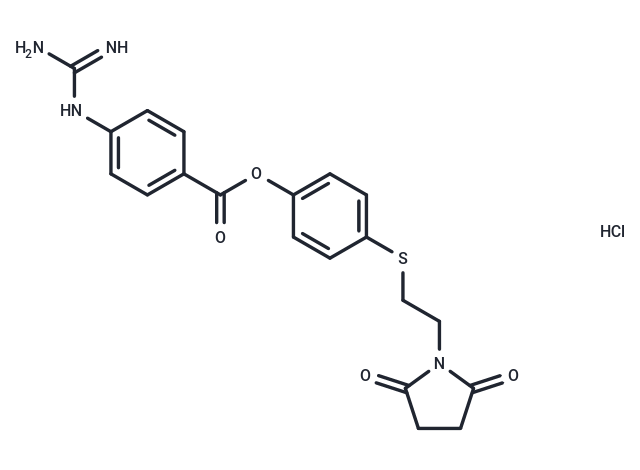Shopping Cart
Remove All Your shopping cart is currently empty
Your shopping cart is currently empty
Patamostat HCl is a highly potent and selective small molecule protease (protease) inhibitor that inhibits trypsin, fibrinolytic enzymes, and thrombin with IC50 values of 39 nM, 950 nM, and 1.9 μM, respectively.Patamostat HCl is used in the study of acute pancreatitis.

| Pack Size | Price | USA Warehouse | Global Warehouse | Quantity |
|---|---|---|---|---|
| 1 mg | $195 | - | In Stock | |
| 5 mg | $465 | - | In Stock | |
| 10 mg | $679 | - | In Stock | |
| 25 mg | $1,070 | - | In Stock | |
| 50 mg | $1,430 | - | In Stock | |
| 100 mg | $1,930 | - | In Stock |
| Description | Patamostat HCl is a highly potent and selective small molecule protease (protease) inhibitor that inhibits trypsin, fibrinolytic enzymes, and thrombin with IC50 values of 39 nM, 950 nM, and 1.9 μM, respectively.Patamostat HCl is used in the study of acute pancreatitis. |
| Targets&IC50 | Thrombin:1.9 μM, Trypsin:39 nM, Plasmin:950 nM |
| In vivo | In rats or rabbits, Patamostat (intravenous infusion) at doses of 0.03-0.3 mg/kg or 0.3-3.0 mg/kg, respectively, reduces mortality after the induction of pancreatitis in a dose-dependent manner[1].In dogs with pancreatitis, Patamostat (intravenous infusion) at doses of 1.0-3.0 mg/kg reduces the increases of serum trypsin and lipase activities[1].In male Wistar rats, continuous infusion of Patamostat (2 mg/kg per h) improves almost all parameters, including mortality rate, serum and ascitic fluid amylase levels, plasma endotoxin and serum FDP levels, and distribution of lysosomal enzyme[2]. |
| Synonyms | Patamostat HCl(114568-26-2 Free base) |
| Molecular Weight | 448.92 |
| Formula | C20H21ClN4O4S |
| Cas No. | 3031765-17-7 |
| Smiles | O=C(C1=CC=C(NC(N)=N)C=C1)OC2=CC=C(C=C2)SCCN3C(CCC3=O)=O.Cl |
| Relative Density. | no data available |
| Storage | Powder: -20°C for 3 years | In solvent: -80°C for 1 year | Shipping with blue ice/Shipping at ambient temperature. | |||||||||||||||||||||||||||||||||||
| Solubility Information | DMSO: 50 mg/mL (111.38 mM), Sonication is recommended. | |||||||||||||||||||||||||||||||||||
Solution Preparation Table | ||||||||||||||||||||||||||||||||||||
DMSO
| ||||||||||||||||||||||||||||||||||||
| Size | Quantity | Unit Price | Amount | Operation |
|---|

Copyright © 2015-2026 TargetMol Chemicals Inc. All Rights Reserved.